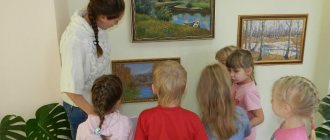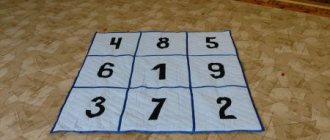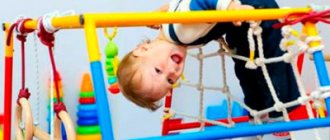Development of aesthetic perception, taste, feelings and ideas of children
Elena Korobkina
Development of aesthetic perception, taste, feelings and ideas of children
From the first years of life, a child unconsciously reaches out to everything bright and attractive, rejoices in shiny toys, colorful flowers and objects . All this gives him a feeling of pleasure and interest. The word "beautiful"
enters
children's . From the first year of life, they hear a song, a fairy tale, look at pictures; simultaneously with reality, art becomes the source of their joyful experiences. In the process of aesthetic education, they undergo a transition from an unconscious response to everything bright and beautiful to a conscious perception of beauty .
Aesthetic perception of reality has its own characteristics. The main thing for him is the sensory form of things - their color, shape, sound. Therefore, its development requires a large sensory culture.
Beauty is perceived by a child as a unity of form and content. Form is expressed in a combination of sounds, colors, lines. However, perception becomes aesthetic only when it is emotionally charged and associated with a certain attitude towards it .
Aesthetic perception is inextricably linked with feelings and experiences. A feature of aesthetic feelings is disinterested joy, a bright emotional excitement that arises from meeting the beautiful.
The teacher must lead the child from the perception of beauty , emotional response to it to understanding, the formation of aesthetic ideas , judgments, and evaluations. This is painstaking work, requiring the teacher to be able to systematically, unobtrusively permeate the child’s life with beauty, and in every possible way to ennoble his environment.
2.2 Objectives and methods of aesthetic education
The tasks of aesthetic education of preschool children , based on its goal, can be presented in two groups .
The first group of tasks is aimed at developing children’s aesthetic attitude towards their surroundings . The following is provided : to develop the ability to see and feel beauty in nature , actions, art, to understand beauty; cultivate artistic taste , the need for knowledge of beauty.
The second group of tasks is aimed at developing artistic skills in the field of various arts: teaching children to draw , sculpt, design; singing, moving to music; development of verbal creativity.
The named groups of tasks will give a positive result only if they are closely interconnected in the implementation process.
The leading methods for solving problems of the first group are demonstration, observation, analysis, and the example of an adult. Showing as a method of education is used during initial acquaintance with the subject of aesthetic reality . It is important for the teacher to determine the object of the display and create conditions so that the children’s is focused on what they are shown and asked to listen to .
When using these methods, it is very important that the teacher knows how to show his feelings , his attitude, and knows how to express feelings . The expressiveness of intonation when reading a poem, sincere delight at a beautiful thing, genuine grief when encountering negligence in clothing, sloppiness, a bright emotional manifestation of one’s feelings serves as an active method of influencing a child, since it is based on a feature of childhood - imitation.
To solve problems of the second group, practical methods are required as leading ones: demonstration, exercise, explanation, method of search situations. These methods are discussed in detail in the methods of visual activity and music education .
The general principle of selecting methods is to find methods and techniques that would support children’s desire to create “works of art”
, with your own hands (sculpt, draw, craft, decorate,
take part in various types of artistic activities. Creative tasks are useful, they and any manifestation of creativity must be combined with teaching the skills of artistic expression. If a child does not have drawing skills, he will not be able to create something then creative, despite the conventional understanding of this term in relation to preschoolers. That is why direct teaching methods are needed: demonstration, exercise, examination of objects , description. In these cases, learning becomes one of the factors that stimulate creativity, and creative tasks give learning a developmental character .
4. Formation of the foundations of aesthetic taste
Aesthetic taste is manifested in the fact that a person receives pleasure, spiritual pleasure from meeting true beauty in art, in life, in everyday life. Aesthetic taste is a broad concept ; it includes not only understanding, enjoying deep, beautiful works of art. But also an understanding of the beauty of nature, work, life, clothing.
In the formation of aesthetic taste in children, education plays a large role. In classes, preschoolers are introduced to classic works of children's literature, music, and painting. Children learn to recognize and love true works of art accessible to their age.
Getting acquainted with a folk tale, with the works of S. Ya. Marshak, S. V. Mikhalkov, K. I. Chukovsky, listening to the works of P. I. Tchaikovsky, D. B. Kabalevsky and other composers, children begin to become familiar with the beauty and richness of artistic words, music. All this gives them true pleasure, is remembered and forms the basis of artistic taste .
By instilling in children the basics of aesthetic taste , we teach them to see and feel the beauty of the world around them, and to cherish it. It is better to keep a flower in a flowerbed, but in order for it to bloom and bring joy to others, it must be looked after. Cleanliness in the group, which creates comfort and beauty, must be maintained, not littering, and putting away toys and books. Thus, in the process of education and training, the tasks of aesthetic education in preschool age are carried out.
5. Conditions and means of aesthetic education
Aesthetic education of children is carried out by familiarizing children with the aesthetics of everyday life , with the beauty in work, in nature, social phenomena, and the means of art. Teaching a child to feel and understand the beauty of life is a big and difficult task that requires long-term work by adults.
To implement the tasks of aesthetic education of children, certain conditions are necessary . First of all, this is the environment in which the child lives and develops . It has an impact on the child that can hardly be compared with others in its strength and significance. If the environment is aesthetic , beautiful (not necessarily rich, if the child sees beautiful relationships between people, hears beautiful speech, etc., then from an early age he will accept the aesthetic environment as the norm , and everything that differs from the norm will cause his rejection. The aesthetics of everyday life includes many details. This is the aesthetics of the environment : the things that surround the child and which he uses, toys, clothes of the baby and the people around him, the design of the premises, etc. Beautiful things “please the eye”
, evoke positive emotions and the desire to maintain them.
“white tablecloth”
theory is quite fair: if we want to
cultivate not only neatness, but also the need for an aesthetic environment , we must eliminate unaestheticism as such . From the first years of a child’s life, it is important both at home and in a preschool institution to pay attention to the aesthetics of everyday life .
The aesthetics of everyday life in a kindergarten is manifested in artistic simplicity, in a thoughtful selection of household items , where each thing has its own place, where there is nothing superfluous. The walls should be painted in calm, light colors.
Requirements for the design of a kindergarten are determined by the tasks of protecting the life and health of children , the content of educational work with them . The main ones are:
- Expediency, practical justification of the situation.
-Purity, simplicity, beauty.
-The correct combination of color and light, creating visual contrast, ensuring the visibility of each object .
All design components must form a single ensemble.
The concept of “ everyday aesthetics ”
includes the beauty of everyday relationships between people who surround the child. It is very important what kind of speech he hears, what intonations. It is necessary that it be correct, figurative, rich in intonation and friendly.
The aesthetics of everyday life is also a person’s appearance. Carelessness, untidiness in clothing, awkwardness in the selection of colors, inability to find your own style - all this is contrary to the law of beauty.
The aesthetics of everyday life is an indispensable condition for the aesthetic education of a child , the background that reinforces or destroys his or her ideas about beauty .
Three rules: to live in beauty, to notice beauty, to support and create beauty around oneself - make the aesthetics of everyday life a means of aesthetic education of a child .
Nature is a powerful means of .
It is in it that you can see harmony - the basis of beauty: a variety of colors, shapes, sounds in their combination. Nature itself is a condition for the comprehensive education and development of a child . It becomes a means when an adult purposefully uses its “ educational capabilities ”
and makes it clear for the child.
The teacher reveals to children the world of nature, helps them see its beauty in a drop of dew on a bud, and in the interweaving of grasses, and in the colors of the sunset... You just need to see this beauty for yourself and find words that are accessible to the child’s heart. Works of art about nature will provide him with invaluable help in this, which he must know well and skillfully use. In education using the means of nature, it is necessary not only a passive contemplative, but also an effective principle (to protect nature, to help it)
.
Social life, the work of people with whom the child constantly encounters, is also an important means of aesthetic education . The well-coordinated work of builders makes children want to create a good building, act together, and be attentive to each other. Descriptions of the work of sailors, pilots, teachers, and doctors not only introduce preschoolers to these professions, but also make them want to imitate them. All this is reflected in their games and contributes to the education of moral and aesthetic feelings .
Therefore, the teacher thoroughly prepares for excursions, during which children receive and accumulate the sensory experience . Excursions, when properly prepared and conducted, broaden the horizons of preschoolers, teach them to see, compare, generalize, which forms the basis for the development of creative imagination and abilities.
A multifaceted and inexhaustible means of aesthetic education is art : fine art, music, literature, architecture, theater, cinema. The early introduction of children to real high art contributes to the emergence in the child's soul of a truly aesthetic perception of reality . Each type of art reflects life in its own way and has its own special impact on the child’s mind and feelings .
From the first years of life, children are accompanied by oral folk art and children's literature. A fairy tale occupies a special place in their lives.
Not everything can be expressed in words. There are shades of feelings that can be expressed more deeply and fully in music. Music sharpens emotional responsiveness. The child needs it. “Childhood is just as impossible without music as it is impossible without games, without fairy tales,” V. A. Sukhomlinsky was convinced of this.
A condition and means of aesthetic education is the artistic activity of preschoolers, both organized by the teacher and independent. Fine art is necessary for a child. It gives him rich visual images.
In artistic activity, as a rule, there is a reproducing (reproductive)
factor and creative.
Both are necessary and interconnected - a child cannot create without learning to reproduce .
All of the above-mentioned means of aesthetic education - everyday life , nature, art, activity - are effective both on their own and in conjunction, but oversaturation is just as harmful to development as a lack of emotional impact. We must search and find the golden mean.
Forms of organization of aesthetic education
Aesthetic education of children in a preschool institution is carried out in different forms depending on the principle of guiding their activities, the method of uniting preschoolers, and the type of activity.
The teacher manages the development process of children . Children themselves love artistic activities, and often engage in them on their own initiative. It cannot be said that independent artistic activity is completely carried out without the guidance of an adult. It's just that the nature of this guide is indirect. The teacher takes care of the child’s accumulation of experience and impressions, which will later be reflected in independent drawing, modeling, stories, and musical activities; teaches visual arts and techniques.
Independent artistic activity arises on the initiative of children to satisfy their individual needs: make a gift for mom, make a toy for playing, etc. The teacher’s task is, without violating the child’s plan, to help him if such a need arises. The teacher develops children's independence using hints, drawing attention to a subject , object, questions, suggestions , assessing the results and level of independence, fiction, fantasy.
Independent activity can be individual in nature, and sometimes children unite in groups of two or three and, having discussed their idea, together prepare a concert, draw scenery, make attributes for the game, organize a theatrical game, etc.
Signs of independent activity are the child’s attention to the means of expressiveness in music, movements, drawing, speech and the ability to transfer what he has learned into his own new activities and apply them to solve new problems.
Independent artistic activity is closely related to the work that the teacher . These can be organized classes on speech development , visual arts, or music. They are included in the mandatory “grid”
weekly classes are conducted systematically according to pre-developed content and in order of increasing complexity.
The teacher organizes excursions into nature, to monuments, to a museum, to a festively decorated street, etc. The teacher’s task is to think through the content of the excursion, taking into account the laws of children’s perception and educational tasks . to determine in advance the location of the excursion, the method of placing children aesthetic feelings in them .
One of the forms of children's activities that contribute to aesthetic education is theatrical games and dramatization games. These games are held under the guidance of a teacher .
entertainment occupy a significant place in the pedagogical process of a preschool institution and in the lives of children .
Entertainment as a form of work with preschool children is held once every two weeks. entertainment content . These can be themed literary and musical evenings.
Entertainment is useful for . A variety of material is selected - literary, musical, and visual on the same topic.
Such evenings of entertainment bring joy to preschoolers, introduce them to national culture, and cultivate aesthetic feelings .
Holidays in preschool institutions correspond to those accepted in our country. They can be divided into holidays associated with public life (February 23, May 9, June 12, etc., and holidays associated with folk and religious traditions (Easter, Maslenitsa, Christmas, New Year)
.
There may be holidays that reflect local events (City Day, as well as our own, kindergarten ones (anniversary of a preschool institution, group birthday, etc.)
. When holding holidays, a set of
educational tasks is solved - moral, intellectual, as well as physical education . And of course, they implement the tasks of aesthetic education ...
The holiday should be emotionally rich. The beauty of the setting, the solemnity of the music, the general high spirits - all this increases sensitivity to the aesthetic side of reality. Children want to actively participate in the holiday, they are not satisfied with the role of observers. And the teacher is given the opportunity satisfy the desires and need for activity of each child. You just need to choose the right form of activity for each of the pupils . One will read poetry, another will sing, the third will dance. You cannot deprive any of the children of the opportunity to show what they are capable of and feel equal in an atmosphere of general joy.
Aesthetic education of preschool children can be organized in different forms, and these forms have their own qualifications.
7. Conclusion
of aesthetic education are put forward in kindergarten :
Systematically develop the perception of beauty , aesthetic feelings , and ideas of children . All types of art, nature and everyday life contribute to this, causing immediate emotional responsiveness, joy, excitement, admiration, and passion.
Involve children in activities in the field of art, cultivating in them the need and habit of introducing elements of beauty into everyday life, nature, and social relations.
To form the foundations of children’s aesthetic taste and the ability to independently evaluate works of art and life phenomena.
Develop children's artistic and creative abilities . Their activities related to art should always be relaxed, full of joyful aspiration, creative imagination, and initiative. The more aesthetically developed a child is , the stronger his artistic skills and abilities are, the more fully his creative activity develops
The leading place in the implementation of aesthetic education belongs to kindergarten. But the role of the family is also great. Only with the unity of the influences of the kindergarten and the family is it possible to fully implement the tasks of aesthetic education . Not every child will become a musician or artist, but every child can and should develop a love and interest in art, develop aesthetic taste , an ear for music, and basic drawing skills.
The teacher helps the family create the necessary conditions for the proper aesthetic education of children . He talks about the importance of everyday aesthetics , advises what to read to children, what records to buy for listening to music, and ensures that the child in the family has everything necessary for the manifestation of children's creativity: an album, pencils, paints, toys, books.
Establishing continuity in the aesthetic education of kindergarten and family forms the fundamental principles of the spiritual culture that a person should have.
How drawing develops aesthetic taste
One of the best ways to develop a child's aesthetic taste is to enroll him in drawing classes for children. During the learning process, the child learns not only to reproduce real images on paper or canvas, but also to see the essence, character, and mood of the picture being created. In addition, contact with your own feelings and emotions is restored. He can manifest them through drawings and live them safely in his creativity.
And during the classes, the teacher introduces students to the works of classics and modern artists. By comparing, finding similar things, forming his preferences, the child penetrates deeper into art and awakens a love for beauty in his soul.
Drawing lessons for children at the Children's Producer's School are structured in such a way as to reveal the artistic talent in each student, form imaginative thinking, develop fine motor skills and develop an aesthetic attitude towards the world around them.
We are waiting for your children at Names Production!
Peculiarities of perception in younger preschoolers
In early preschool age, perception is characterized by the following features:
- The inseparability of a property from an object. The big fluffy tiger at the zoo will be called a kitty.
- When studying objects, the most vivid, memorable detail stands out. That is why the wide witch's hat in the picture turns all the elegant old ladies on the street into evil witches.
- A sharp change in the usual surroundings around a familiar object prevents the baby from identifying it. Mom and dad in ballroom dresses become strangers.
Such specificity is typical for children of 3-4 years of age; in the future, perception will become more differentiated, individual functions will be highlighted, and the whole will be fragmented into particulars.
Perception of space by children 3 - 4 years old
The difficulty of understanding space lies in the inability to touch, smell and see it. The first step is to recognize the “close” space, that is, the surrounding world at arm’s length with the toy.
Subsequently, the younger preschooler begins to understand the concepts of “far and close,” but they are not accurate. The small statues on the bridge may appear to be dolls, and the child may well ask the mother to get one of them.
According to research, in order for a preschooler to begin to correctly perceive space, he must first evaluate his own body in this world. Learn to distinguish and name arms and legs, understand which parts of the body are paired. An additional way to master the concept of space is the constant work of an adult aimed at indicating the direction. The more often the words “right”, “left”, “side”, “in front”, “above” are heard, the easier it will be for the baby to master orientation in space.
The next stage is tasks to compare length, width and height. Over time, the child begins to solve such tasks “by eye,” demonstrating an understanding of what space is and how people and objects are located in it.
Color perception
The difference in colors is available to the baby from an early age. Now we are not talking about the finest shades, but it highlights the main tones of the spectrum.
At 3-4 years old, a preschooler clearly distinguishes 4 primary colors:
- Red;
- Yellow;
- Blue;
- Green.
This aspect is associated with the age-related feature of seeing the main thing, discarding the unimportant, that is, incomprehensible and unknown shades. Data and reference shades are learned casually, without special training. But in order for the baby not to suffer from “poverty” of color perception, the names of the remaining tones and shades must be named and shown to him.
Children tend to replace color with the concepts of “beautiful” and “ugly,” which results in pictures where the shades of objects do not closely correspond to reality. In this age period, colors are discarded as an unimportant factor, and form becomes the basis.
Therefore, the development of color perception should consist of exercises where the simplest tasks of adding up an elementary color figure are replaced by more complex ones.



